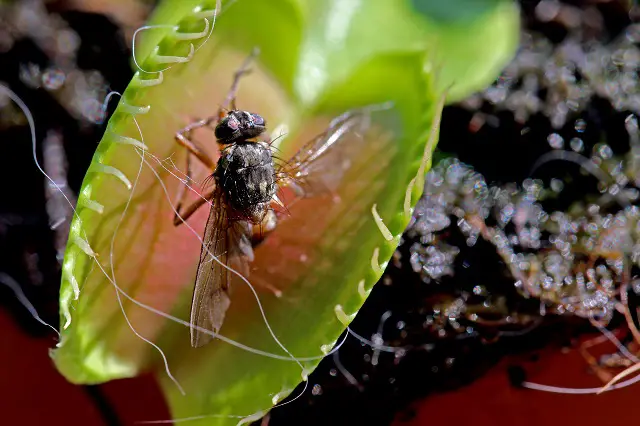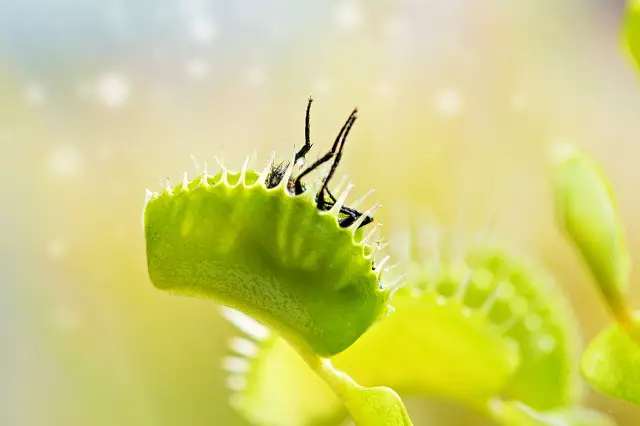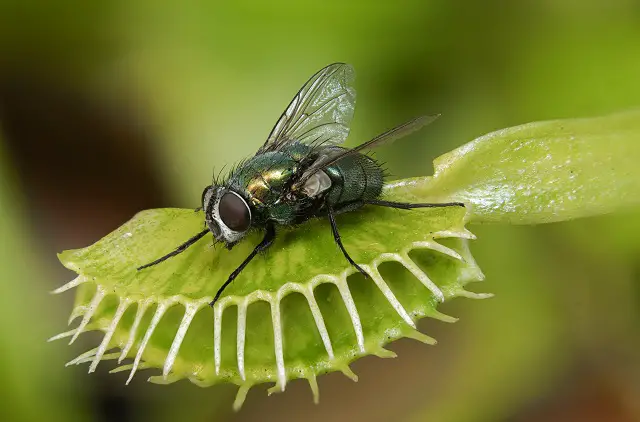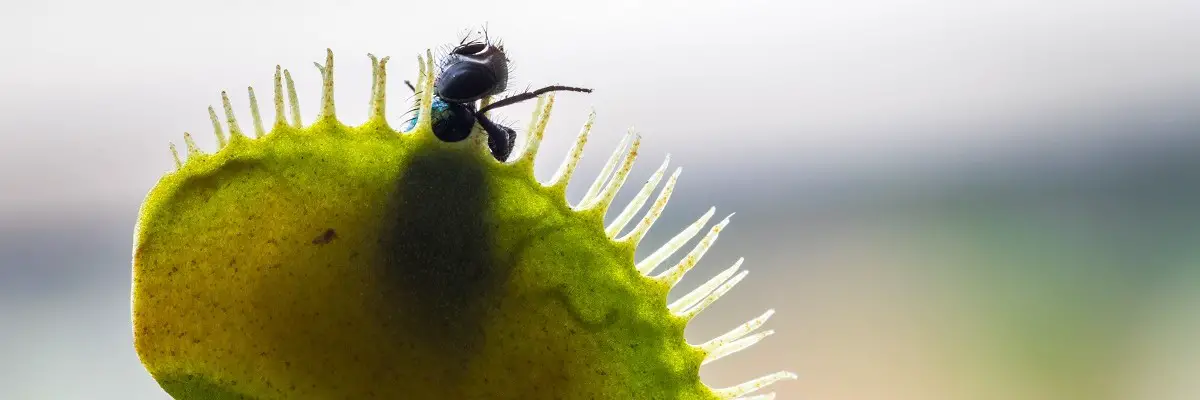Do Venus Flytraps Attract House Flies: Venus flytraps are carnivorous plants that have been around for centuries. They’re known for their ability to catch and eat small insects, such as flies. But do they attract house flies specifically? The answer is yes — but not in the way you might expect.
Houseflies are attracted to decaying organic matter, like dead animals or rotting fruit, which provide them with a source of food and shelter from predators. So while Venus flytraps don’t actively attract houseflies, they can be found near these areas because the plant provides an additional source of food and protection from other predators in the area. In addition to this passive attraction, some research has shown that certain species of houseflies may also be drawn by chemical signals released by Venus flytrap leaves when stimulated (e..g., when touched). These chemicals act as a lure for unsuspecting prey items – including those pesky household pests!
While it’s true that venus fly traps can draw in certain types of flies – including houseflies – it’s important to note that this isn’t necessarily something you should encourage if you’re trying to get rid of your pest problem! Instead, focus on eliminating sources where these bugs find food and shelter – such as piles or composted material outside your home – so there won’t be any reason for them to come inside looking for sustenance. Additionally, using insecticides or natural repellents indoors will help keep flying pests away from your living space altogether.
Do Venus flytraps keep flies away?
Do Venus flytraps actually keep flies away? The answer is yes – although they don’t work as a traditional insect repellent, they can help reduce the number of flying pests in your home or garden.
The Venus flytrap is an incredibly effective predator that uses its specialized leaves to trap prey such as flies, spiders, and other small insects. When an insect lands on the leaf, it triggers tiny hairs inside, which cause it to close shut like a clam shell around its victim within seconds – trapping them until digestion begins! This means that any potential prey will be quickly taken care of before there’s even time for them to become nuisance pests in your home or garden.
In addition to capturing individual bugs before they become annoying nuisances themselves, having Venus Fly Traps around may also act as ‘floral lures’ by attracting other bugs into their traps, potentially leading more away from you! This works because certain species, such as moths, are attracted by sweet-smelling nectar produced by these carnivorous plants; when this happens, some may get stuck while others might get scared off due either way fewer overall numbers end up near you!
Furthermore, if you want extra protection against pesky flying critters, then consider adding things like sticky strips (which catch anything walking across), hanging pheromone traps (which attract male moths), or even natural predators like praying mantises all over your yard/garden – these should help supplement what little effect Venus Fly Traps have on keeping those particular types at bay.

Do Venus flytraps catch many flies?
Do Venus flytraps actually catch many flies? The answer is yes – but not as many as you might think.
The truth is that Venus flytraps don’t rely on catching many flies to survive. In fact, they can go for months without eating anything at all! That being said, these unique plants have evolved an impressive set of features that allow them to capture prey with surprising efficiency when food does become available.
The first step in the process occurs when a potential meal lands on or near the plant’s leaves – usually attracted by its sweet-smelling nectar glands located around its edges. As soon as contact is made between the insect and leaf surface, two sensitive hairs inside each trap will be triggered simultaneously within 0 – 0 .5 seconds; if this happens twice more within 20 seconds, then it triggers an irreversible ‘snap trap’ mechanism which closes shut like a pair of jaws trapping whatever has been unfortunate enough (or lucky enough!) To wander into range!
Once closed tight around its victim, there are no escape routes left open, so digestion begins almost immediately; enzymes secreted from cells lining the inner walls break down proteins and other nutrients from what was once living matter into useful energy sources for sustaining growth over longer periods than would otherwise be possible through photosynthesis alone (which only provides short bursts). This combined system allows Venus Flytrap populations to thrive even during times when food supplies may be scarce due to seasonal changes or environmental stressors such as drought etc.…

Do flies feel pain on fly traps?
The answer is complicated, but it appears that, yes, under certain circumstances, some forms of pain may be felt by trapped flies.
The first thing to consider is what kind of “pain” we are talking about here. In humans and other animals with nervous systems, pain is caused by physical damage to tissues or nerves, which stimulates specialized nerve cells called nociceptors (or “pain receptors”). These cells then send signals along nerve pathways leading up to our brains, where we experience sensations like burning or stinging from an injury. Since insect bodies lack this type of complex nervous system architecture–and therefore don’t possess any true nociceptors–it’s unlikely that a trapped fly would experience anything comparable to human-like physical discomfort from being stuck inside a Venus fly trap’s leaves.
However, there may still be something going on for the poor little bug! Insects do have mechanical sensors in their exoskeletons known as proprioceptors which detect changes in pressure against their bodies (e..g., squeezing) and can cause them reflexive reactions such as jerking away or trying to escape whatever object has applied pressure against them – much like how our own muscles react when someone pinches us too hard! So while it’s not likely that a captured insect experiences anything close to human-like suffering while stuck inside its captor plant, at least one study suggests they will try just about everything possible within their limited means — including chewing off parts of themselves —to escape once ensnared by those hungry leaves!
All things considered, though – even if these bugs aren’t feeling actual “pain” per se – seeing your dinner struggle so desperately must still make for an unpleasant spectacle no matter who you are…which might explain why many people opt out of feeding live prey directly into their carnivorous pet plants altogether instead preferring more humane methods involving dead food items placed directly onto trigger hairs located near each leaf blade opening. Whatever method you choose, however, always remember never to feed your venus flytrap too often lest it risk overstressing its delicate digestive system!

How many flies does a Venus flytrap need?
When most people think of the Venus flytrap, they tend to imagine a single plant catching hundreds of flies at once. However, this isn’t necessarily true; one healthy adult Venus flytrap only needs two or three insects per week to survive and thrive! That means if you were planning on keeping one as a pet or putting it into your garden, then you don’t have much to worry about when it comes to overfeeding them.
But why do these plants require so few prey items? The answer lies in their unique digestive process, which allows them to capture small bugs by trapping them inside their leaves and extracting all the necessary nutrients from those creatures without having any waste left behind. This helps ensure that the plants are getting enough nutrition while avoiding wasting energy trying (and failing)to consume too many meals at once – something which would be difficult with such tiny mouths!
Additionally, because they can store food within their bodies until needed, there’s no rush for nourishment either, meaning even if an individual trap fails to capture anything during its weekly hunt, there should still be plenty stored up already waiting inside each leaf ready whenever hunger strikes again later down the line!
So overall, we can conclude that although some may believe otherwise due to largely mythical tales surrounding this species – generally speaking, these amazing little traps will never need more than two-three insect snacks every seven days to keep themselves ticking along nicely throughout the life cycle… making sure everyone involved stays happy both predator & prey alike.


